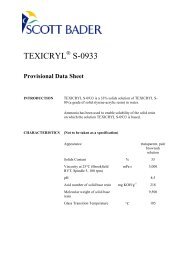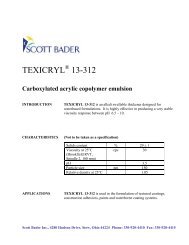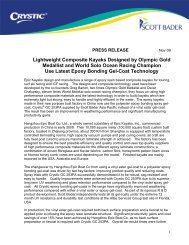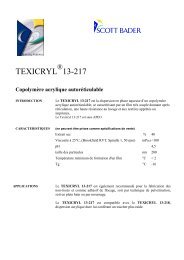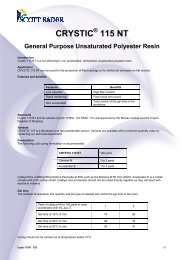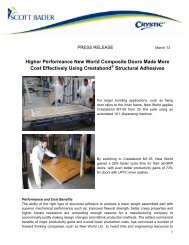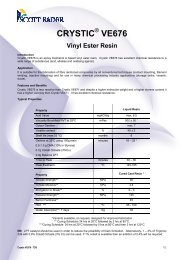Crystic Topcoat LS 97PAX - Scott Bader
Crystic Topcoat LS 97PAX - Scott Bader
Crystic Topcoat LS 97PAX - Scott Bader
Create successful ePaper yourself
Turn your PDF publications into a flip-book with our unique Google optimized e-Paper software.
<strong>Crystic</strong> <strong>Topcoat</strong> <strong>LS</strong> <strong>97PAX</strong><br />
Low Styrene Content Isophthalic <strong>Topcoat</strong> for<br />
Spray Application (Available in a Wide Range<br />
of Colours)<br />
Introduction<br />
<strong>Crystic</strong> <strong>Topcoat</strong> <strong>LS</strong> <strong>97PAX</strong> is a high performance isophthalic topcoat. It is filled, pre-accelerated and formulated for spray<br />
application. This product is available in a wide range of colours and the information contained in this technical datasheet<br />
also applies to pigmented versions.<br />
Applications<br />
<strong>Crystic</strong> <strong>Topcoat</strong> <strong>LS</strong> <strong>97PAX</strong> is designed for use where smooth finish is required on the reverse side of a laminate.<br />
Product characteristics<br />
The product should be conditioned at workshop temperature (18°C – 25°C) and mixed before use. <strong>Crystic</strong> <strong>Topcoat</strong> <strong>LS</strong><br />
<strong>97PAX</strong> requires the addition of a catalyst to start the curing reaction. Use Butanox M50 (or other equivalent catalyst) and<br />
incorporate this into the gelcoat at 1–2% v/w. Unsaturated polyester products release heat when they cure in bulk. If<br />
manually adding catalyst to the product prior to spraying, do not prepare more material than is required to complete the<br />
job and spray within 3 minutes. Ensure that all equipment is thoroughly cleaned after use.<br />
Do<br />
• Gently stir the topcoat before use, by hand or with a low shear mixer<br />
• Ensure workshop temperature is between 18 and 25°C<br />
• Spray at the minimum pressure to achieve an acceptable spray pattern<br />
• Apply the gelcoat in thin even passes, building up the film thickness to 0.5- 0.6 mm wet<br />
• Ensure adequate mould ventilation.<br />
Don’t<br />
• Exceed a wet film thickness exceeding 0.8 mm or drainage may occur<br />
• Allow vapour to be retained in deep mould sections, this can slow cure.<br />
Additives<br />
The addition of fillers can adversely affect the quality of the surface achieved.<br />
Recommended Testing<br />
It is recommended that customers test <strong>Topcoat</strong> <strong>LS</strong> <strong>97PAX</strong> before use under their own conditions of application to ensure<br />
the required surface finish is achieved.<br />
Post Curing<br />
Laminates take time to cure fully and develop mechanical properties at room temperature. This process can be<br />
accelerated by post-curing at elevated temperature. Please seek advice for your specific needs. Optimum properties can<br />
normally be obtained by allowing curing for 24 hours at ambient temperature followed by 3 hours at 80°C.<br />
<strong>Crystic</strong> <strong>LS</strong> <strong>97PAX</strong> <strong>Topcoat</strong> - TDS 1/2
Typical Properties<br />
The following table gives typical liquid properties of <strong>Crystic</strong> <strong>Topcoat</strong> <strong>LS</strong> <strong>97PAX</strong> when tested in accordance with <strong>Scott</strong><br />
<strong>Bader</strong> test methods.<br />
Properties for ‘RAL 9003’ <strong>Topcoat</strong> Method Typical Value<br />
Viscosity, 25°C 0.6s-1 3.41 250 poise<br />
Viscosity, 25°C 4500s-1 3.6 2.4 poise<br />
Specific Gravity at 25°C (white gelcoat) 8.01 1.2<br />
Stability at 20°C - 3 months<br />
Geltime 25°C 2% Butanox M50 (or other<br />
equivalent catalyst)<br />
5.25 7<br />
Typical Properties<br />
The following are typical mechanical properties obtained from the topcoat base resin following a postcure of 24hrs at<br />
50°C and tested as specified in BS EN ISO12215-1: 2000.<br />
Mechanical properties Method Value (2 s.f.)<br />
Barcol Hardness (Model 934-1) EN59 36<br />
Heat Deflection Temperature BS EN ISO 75-2 (1996) 63°C<br />
Water Absorption 24 hours at 23°C BS EN ISO 62 part 6.2 17 mg<br />
Tensile Strength BS EN ISO 527- 2 74 MPa<br />
Elongation at Break BS EN ISO 527- 2 4.7 %<br />
Flexural Strength BS EN ISO 178 110 MPa<br />
Flexural Modulus BS EN ISO 178 2800 MPa<br />
Storage<br />
<strong>Crystic</strong> <strong>Topcoat</strong> <strong>LS</strong> <strong>97PAX</strong> should be stored in its original container and out of direct sunlight. It is recommended that the<br />
storage temperature should be less than 20°C where practical, but should not exceed 30°C. Ideally, containers should be<br />
opened only immediately prior to use.<br />
Packaging<br />
<strong>Crystic</strong> <strong>Topcoat</strong> <strong>LS</strong> <strong>97PAX</strong> is supplied in 25kg and 225kg containers.<br />
Health & Safety<br />
Please refer to Material Safety Data Sheet.<br />
Version 2: February 2013<br />
All information on this data sheet is based on laboratory testing and is not intended for design purposes. <strong>Scott</strong> <strong>Bader</strong> makes no representations or warranties of any<br />
kind concerning this data. Due to variance of storage, handling and application of these materials, <strong>Scott</strong> <strong>Bader</strong> cannot accept liability for results obtained. The<br />
manufacture of materials is the subject of granted patents and patent applications; freedom to operate patented processes is not implied by this publication.<br />
SCOTT BADER COMPANY LIMITED<br />
Wollaston, Wellingborough, Northamptonshire, NN29 7RL<br />
Telephone: +44 (0) 1933 663100<br />
Facsimile: +44 (0) 1933 666623<br />
www.scottbader.com<br />
<strong>Crystic</strong> <strong>LS</strong> <strong>97PAX</strong> <strong>Topcoat</strong> - TDS 2/2





